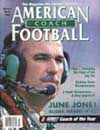AMERICAN FOOTBALL MONTHLY THE #1 RESOURCE FOR FOOTBALL COACHES
Article CategoriesAFM Magazine
|
The Search for The Winning EdgeCreating a Systematic Winning Edge with the Kicking Gameby: Jeff Reinebold Rhein Fire © More from this issue The search for a winning edge drives those of us in the coaching profession. Look at the time and money spent by coaches in search of the latest wrinkle or new idea. We attend clinics, read magazines and books, and at every chance, swap ideas and experiences in hopes of building the proverbial better mouse trap. George Allen, one of modern football's greatest innovators went out on a limb when he convinced the ownership of the Los Angeles Rams to allow him to hire Stanford assistant Dick Vermiel as the NFL's first special teams coach. For the first time, an NFL team had moved to prioritize the role of the kicking game. Since that day, men like Rusty Tillman, Bill Cowher, Scott O'Brien, Frank Ganz, Bobby April, Joe Avezzano and Joe Marciano have elevated the position of special teams coach in the NFL and advanced the science and str....The full article can only be seen by subscribers.
|
|
|||||||
| HOME |
MAGAZINE |
SUBSCRIBE | ONLINE COLUMNISTS | COACHING VIDEOS |
Copyright 2025, AmericanFootballMonthly.com
All Rights Reserved





